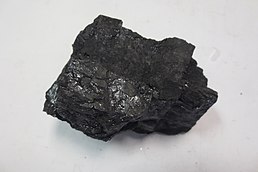
Back Steenkool AF Carbón AN فحم حجري Arabic কয়লা AS Carbón AST K'illima AY Kömür AZ Coal BCL Вугаль BE Вугаль BE-X-OLD
| Sedimentary rock | |
 Bituminous coal, the most common coal grade | |
| Composition | |
|---|---|
| Primary | carbon |
| Secondary | |
| Part of a series on |
| Coal |
|---|
 |
Coal is a combustible black or brownish-black sedimentary rock, formed as rock strata called coal seams. Coal is mostly carbon with variable amounts of other elements, chiefly hydrogen, sulfur, oxygen, and nitrogen.[1] Coal is a type of fossil fuel, formed when dead plant matter decays into peat which is converted into coal by the heat and pressure of deep burial over millions of years.[2] Vast deposits of coal originate in former wetlands called coal forests that covered much of the Earth's tropical land areas during the late Carboniferous (Pennsylvanian) and Permian times.[3][4]
Coal is used primarily as a fuel. While coal has been known and used for thousands of years, its usage was limited until the Industrial Revolution. With the invention of the steam engine, coal consumption increased.[5] In 2020, coal supplied about a quarter of the world's primary energy and over a third of its electricity.[6] Some iron and steel-making and other industrial processes burn coal.
The extraction and burning of coal damages the environment, causing premature death and illness,[7] and it is the largest anthropogenic source of carbon dioxide contributing to climate change. Fourteen billion tonnes of carbon dioxide were emitted by burning coal in 2020,[8] which is 40% of total fossil fuel emissions[9] and over 25% of total global greenhouse gas emissions.[10] As part of worldwide energy transition, many countries have reduced or eliminated their use of coal power.[11][12] The United Nations Secretary General asked governments to stop building new coal plants by 2020.[13]
Global coal use was 8.3 billion tonnes in 2022,[14] and is set to remain at record levels in 2023.[15] To meet the Paris Agreement target of keeping global warming below 2 °C (3.6 °F) coal use needs to halve from 2020 to 2030,[16] and "phasing down" coal was agreed upon in the Glasgow Climate Pact.
The largest consumer and importer of coal in 2020 was China, which accounts for almost half the world's annual coal production, followed by India with about a tenth. Indonesia and Australia export the most, followed by Russia.[17][18]
- ^ Blander, M. "Calculations of the Influence of Additives on Coal Combustion Deposits" (PDF). Argonne National Laboratory. p. 315. Archived from the original (PDF) on 28 May 2010. Retrieved 17 December 2011.
- ^ "Coal Explained". Energy Explained. US Energy Information Administration. 21 April 2017. Archived from the original on 8 December 2017. Retrieved 13 November 2017.
- ^ Cleal, C. J.; Thomas, B. A. (2005). "Palaeozoic tropical rainforests and their effect on global climates: is the past the key to the present?". Geobiology. 3 (1): 13–31. Bibcode:2005Gbio....3...13C. doi:10.1111/j.1472-4669.2005.00043.x. ISSN 1472-4669. S2CID 129219852.
- ^ Sahney, S.; Benton, M.J.; Falcon-Lang, H.J. (2010). "Rainforest collapse triggered Pennsylvanian tetrapod diversification in Euramerica". Geology. 38 (12): 1079–1082. Bibcode:2010Geo....38.1079S. doi:10.1130/G31182.1.
- ^ Wilde, Robert (30 June 2019). "How the Demand for Coal Impacted the Industrial Revolution". ThoughtCo. Retrieved 2 May 2024.
- ^ "Global energy data". International Energy Agency.
- ^ "Lignite coal – health effects and recommendations from the health sector" (PDF). Health and Environment Alliance. December 2018. Archived from the original (PDF) on 11 December 2018. Retrieved 12 February 2024.
- ^ Ritchie, Hannah; Roser, Max (11 May 2020). "CO2 emissions by fuel". Our World in Data. Retrieved 22 January 2021.
- ^ Cite error: The named reference
phys2018was invoked but never defined (see the help page). - ^ "Dethroning King Coal – How a Once Dominant Fuel Source is Falling Rapidly from Favour". Resilience. 24 January 2020. Retrieved 8 February 2020.
- ^ "Analysis: The global coal fleet shrank for first time on record in 2020". Carbon Brief. 3 August 2020. Retrieved 9 November 2021.
- ^ Simon, Frédéric (21 April 2020). "Sweden adds name to growing list of coal-free states in Europe". www.euractiv.com. Retrieved 9 November 2021.
- ^ "Tax carbon, not people: UN chief issues climate plea from Pacific 'frontline'". The Guardian. 15 May 2019.
- ^ Anmar Frangoul (27 July 2023). "IEA says coal use hit an all-time high last year — and global demand will persist near record levels". CNBC. Retrieved 10 September 2023.
- ^ Frangoul, Frangoul (27 July 2023). "Global coal demand set to remain at record levels in 2023". iea. Retrieved 12 September 2023.
- ^ "Analysis: Why coal use must plummet this decade to keep global warming below 1.5C". Carbon Brief. 6 February 2020. Retrieved 8 February 2020.
- ^ "Exports – Coal Information: Overview – Analysis". IEA. Retrieved 20 January 2022.
- ^ Overland, Indra; Loginova, Julia (1 August 2023). "The Russian coal industry in an uncertain world: Finally pivoting to Asia?". Energy Research & Social Science. 102: 103150. Bibcode:2023ERSS..10203150O. doi:10.1016/j.erss.2023.103150. ISSN 2214-6296.